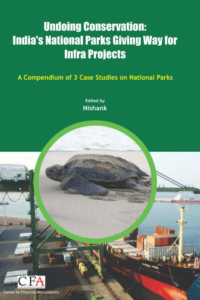 India’s burgeoning economic growth in the last two decades, especially in the infrastructure sector, has heavily impacted its forests and protected areas. Not only has there been a diversion of large tracts of forest land for non-forest purposes, but various infrastructure projects such as roadways, railways, transmission lines, irrigation projects, mining, etc. have also been allowed near or within protected areas, jeopardizing their flora and fauna in the process and negating efforts towards the conservation of important species.
India’s burgeoning economic growth in the last two decades, especially in the infrastructure sector, has heavily impacted its forests and protected areas. Not only has there been a diversion of large tracts of forest land for non-forest purposes, but various infrastructure projects such as roadways, railways, transmission lines, irrigation projects, mining, etc. have also been allowed near or within protected areas, jeopardizing their flora and fauna in the process and negating efforts towards the conservation of important species.
India’s national parks enjoy the highest category of protection among the protected areas and there has been an emphasis on creating “inviolate spaces” devoid of any human activity to provide a suitable atmosphere for the wildlife to thrive on its own. However, at the same time, the growing presence of infrastructure projects, along with mining and tourism projects, passing through the national parks, its buffer zones and the related wildlife corridors pose a threat to these national parks and goes against the principles of creating “inviolate spaces” in these protected areas.
In order to grasp the extent of infrastructure projects coming up within and near protected areas, the Centre for Financial Accountability had earlier published a Mapping Report titled “Rise in Infrastructure Projects in Protected Areas: A Self-Defeating Goal for Development”. This report carried extensive data on projects near and within protected areas, which had either been given or had applied for clearances in the past few years. In order to build a deeper understanding of the impacts of infrastructure projects on protected areas, a Compendium of 10 case studies titled “Undoing Conservation: India’s Tiger Reserves Giving Way for Infra Projects – A Compendium of 10 Case Studies on Tiger Reserves” was commissioned, which focused on tiger reserves spread across the length and breadth of India. It provided key insights into the range of controversial projects which have either come up in these reserves or were planned but have been stalled. In order to further build knowledge in this domain, another compendium of case studies has been envisaged, which focuses on national parks. This brief compendium covers three national parks, the Great Himalayan National Park, Himachal Pradesh; Galathea National Park, Andaman & Nicobar Islands; and Sanjay Gandhi National Park, Maharashtra.
The compendium covers a wide spectrum of infrastructure projects affecting the above mentioned protected areas including hydroelectric projects, a proposed mega-transhipment port, industrial corridors, multimodal corridors, a high speed railway project, and tunneling projects. The individual case studies are preceded by an introductory chapter setting out the legal framework within which efforts towards wild life protection are taking place.
Rather than analyzing the detrimental effects of a single project in the context of any particular national park, juxtaposing the impacts of multiple projects in various national parks gives a better insight into threats looming over these protected areas on a cumulative basis. The aim of these case studies is not only to analyze how the existing national parks may be impacted due to various projects, but also to help see these national parks as rich but fragile biodiversity hotspots home to several species of plants and animals, including several endangered species. These case studies aim to provide a rich source of information for the reader, along with putting forward a reality check of the conservation efforts geared towards these protected areas.
The case studies also make an effort to delve into the larger question of choosing between the anthropocentric approach and the eco-centric approach as the way forward in protecting our protected areas. Clearances for infrastructure projects are often allowed by authorities in the name of public interest or the larger good, which overlooks the corresponding irreversible damages brought by such projects. Protected areas such as national parks are natural habitats that are a culmination of evolutionary processes spanning millions of years. The unique biodiversity of protected areas cannot be sacrificed unquestioningly at the altar of ‘development’, and decisions taken by authorities need to undergo larger public scrutiny.
Often, the justification of ‘unavoidability’ or ‘inevitability’ is used in allowing projects in protected areas. Closer scrutiny reveals that such projects are eventually allowed for higher economic gains or enabling a consumerist energy-intensive lifestyle fueled by prevalent economic models, which are often at loggerheads with the goals of nature conversation. In the end, the onus is on us as a society to decide what we prioritize and how to ensure the sustainable co-existence of all species.
Read and download the resource here: Case Studies Compendium – National Parks
Centre for Financial Accountability is now on Telegram. Click here to join our Telegram channel and stay tuned to the latest updates and insights on the economy and finance.
